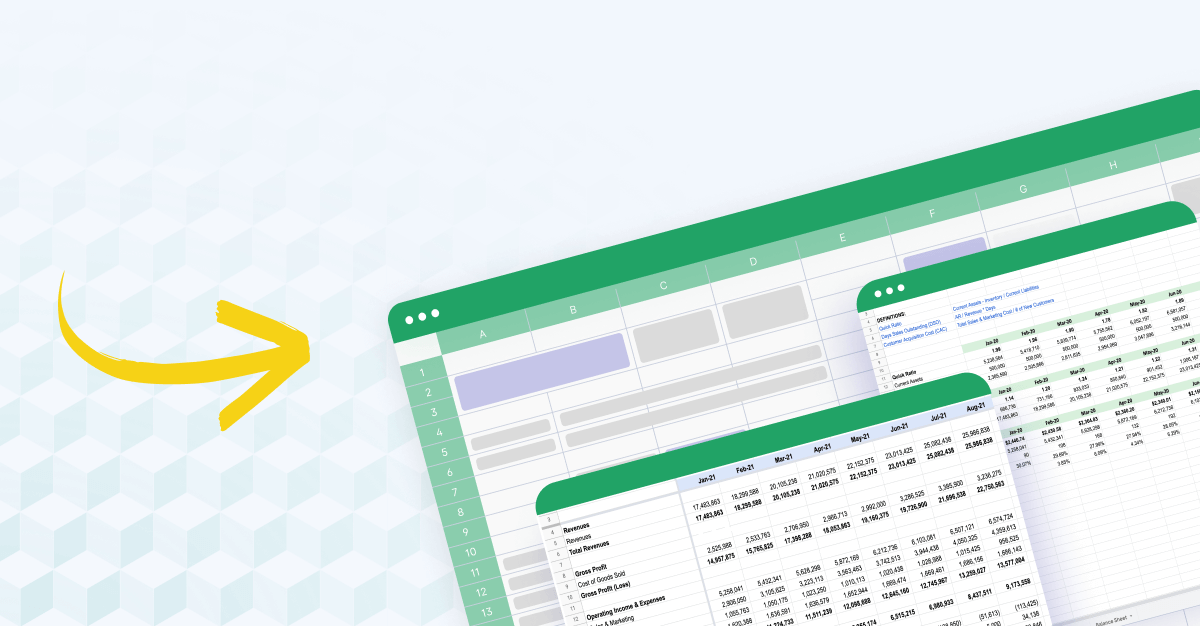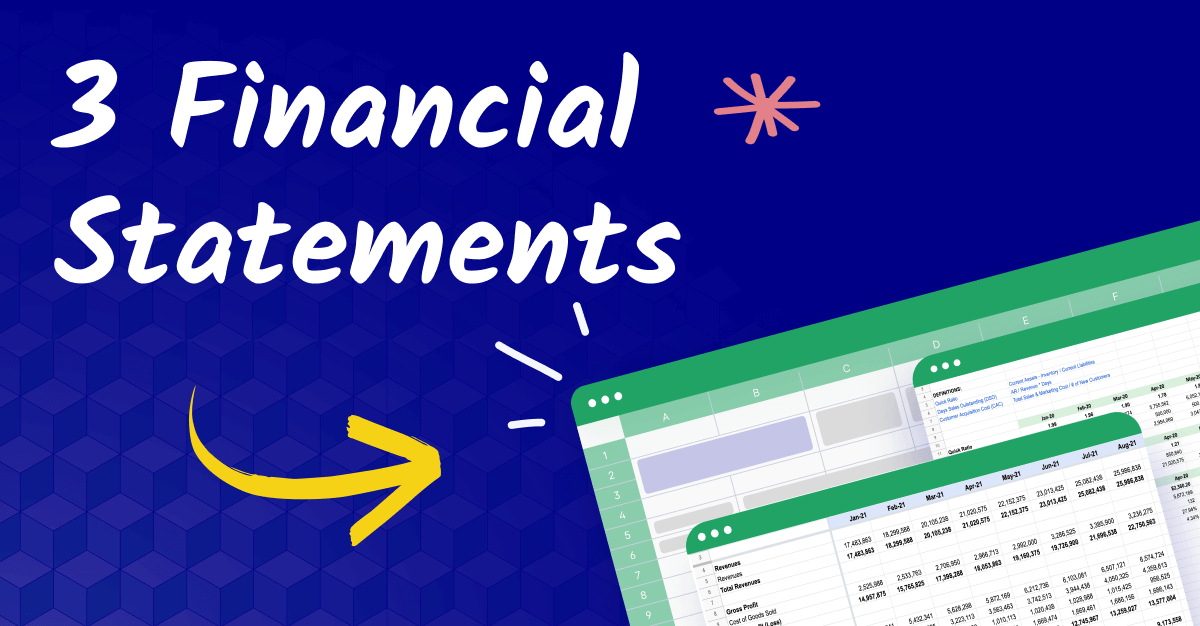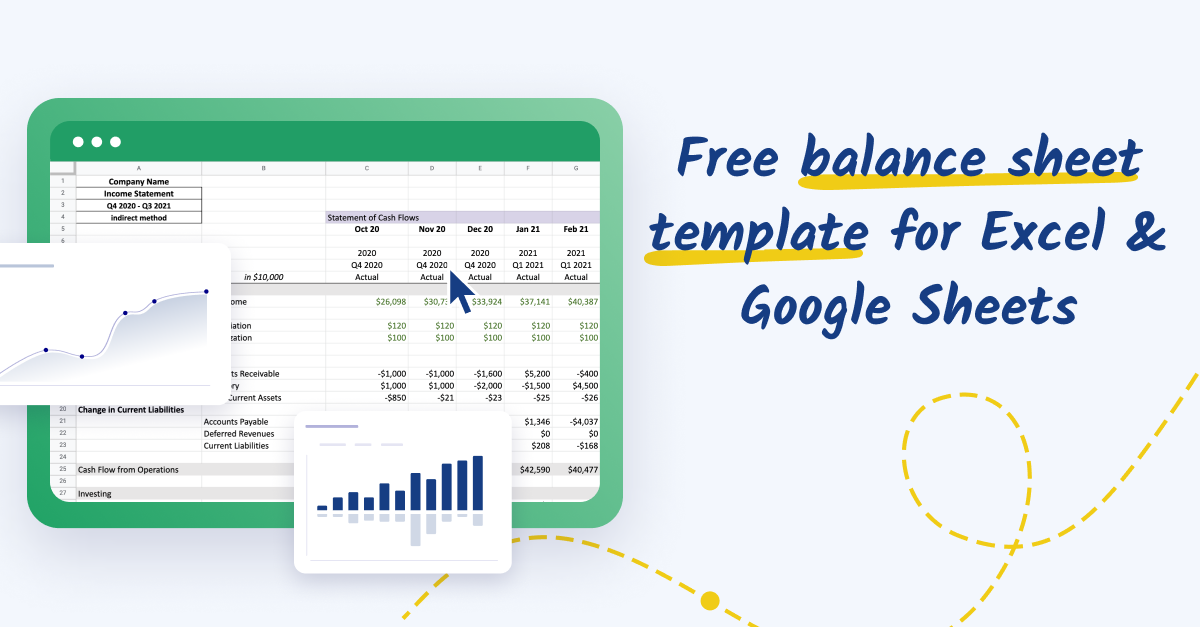Introducing the 4 financial statements
Financial statements provide a snapshot of your company's financials and performance, usually monthly or quarterly.
These four types of financial statements give a detailed financial overview of the company, its cash position, asset holdings, liabilities, and liquidity.
A full set of financials include four basic financial statements: the balance sheet, income statement, cash flow statement, and statement of shareholders' equity. All four accounting financial statements accurately portray the company’s overall financial situation.
- The income statement records all revenues and expenses.
- The balance sheet provides information about assets and liabilities.
- The cash flow statement shows how cash moves in and out of business.
- The statement of shareholders’ equity (also called the statement of retained earnings) measures company ownership changes.
Each type of financial statement offers important insight into various aspects of a company's corporate performance and helps assess its long-term health.
Download a free 3-statement model to get started

How the 4 financial statements work together
Data from the four financial statements flow into each other, working together to provide a comprehensive picture of a company's financial health. By looking at them together, it’s possible to see how well the business is doing financially by examining its profitability and liquidity.
For example, if the income statement shows that the company made significantly more money than it spent, but the cash flow statement indicates that little actual cash came into the company during that period, it may point to issues managing liquidity.
Understanding this relationship between all four financial statements can help CFOs make better-informed decisions about financial strategy.
The income statement
The income statement outlines the company's revenues and expenses. It shows how the company makes money, how much profit it generates, and the sources of its revenue.
A well-crafted income statement provides information on the company's overall financial position. Financial teams use it for financial planning and analysis and to identify areas for improvement in efficiency or cost savings.
Outside investors and lenders also rely on the income statement. Investors assess available investment opportunities by examining the income statement. Lenders use the document to determine if the company can repay potential loans. This document gives investors and creditors a clear picture of how the company uses its resources and allocates them.
How to read the income statement
The income statement starts with your total revenue and subtracts the cost of goods sold (COGS), showing your gross profit at the top.
Next, subtract general expenses from the gross profit total:
These adjustments give you your operating income. From there, subtracting interest expenses and income tax payments gives you total net income.
The balance sheet
This statement shows a company's assets and liabilities—basically “what you own and what you owe.” It provides a snapshot of the company's financial health at a given time and indicates its liquidity and solvency.
It also outlines changes in equity ownership since the prior reporting period.
How to read the balance sheet
The balance sheet shows company assets, liabilities, and equity. In the first section, the balance sheet breaks down company assets:
The second section outlines the debts and obligations the company owes:
- Short term loans
- Leases
- Accounts payable
- Accrued liabilities
- Accrued taxes
- Long-term debts
- Long-term leases
- Deferred tax
If not broken out into the statement of owner equity, the balance sheet outlines:
- Common stock holdings
- Capital in excess of par value
- Retained earnings
- Accumulated comprehensive losses
- Noncontrolling interest
This document quickly provides an overview of the company's non-cash situation, identifies potential income sources (such as selling assets or financial instruments), and evaluates how the company meets obligations over time.
The balance sheet also provides the necessary information to conduct ratio analysis. This helps stakeholders better understand company operations and performance.
Download a free 3-statement model for a consolidated forecast
The statement of owner's equity (statement of retained earnings)
The statement of owner equity is a report that shows the changes in the owners’ capital over time.
It includes contributions made by owners, such as initial investments, subsequent capital contributions, and capital withdrawals. The statement also records gains or losses from business transactions, such as selling or revaluing assets.
The equity statement gives investors an indication of how well the company has been performing financially, both in terms of investments made and profits generated.
By examining the statement of owner's equity, investors can determine whether their investments are growing and if their money is being used effectively.
How to read the statement of owner's equity
- Start with the initial investment made by owners. This will provide a baseline for any subsequent capital contributions or withdrawals.
- Next, analyze gains or losses recorded on the statement due to business transactions, such as revaluing assets or selling them off.
- Finally, look at the net change in the owners’ capital over time. It indicates how well the company is doing financially.
The cash flow statement
This financial document shows the flow of money in and out of a company.
It provides insight into operational health, how the company allocates its resources, where it earns income, and how it spends cash. It provides a quick reference for a company’s overall financial position.
The cash flow statement is one tool investors use to assess profitability at the company, helping them make more informed decisions about investing in or loaning money to a business.
How to read the cash flow statement
You can read the cash flow statement from top to bottom in three sections.
- Operating activities: Money the company made (or lost, in the case of negative amounts) over time. Operating activities include:
- Sales of goods and services
- Interest payments (such as royalty payment receipts income)
- Tax payments
- Accounts payable to suppliers
- Salary
- Rent or lien payments
- Operating expenses
- Investing activities: Purchase or sale of assets, loans to suppliers (for instance, selling services on credit), customer payments, and M&A activities are all included in this section.
- Financing activities: Funding from outside sources like lenders or investors, dividend payments, payments on stock repurchase agreements, etc. It’s also used to record official debt agreements.

How CFOs use financial statements
The CFO interacts with various internal and external stakeholders, educating them on the current status of the company and the potential for future growth.
Here are five ways the finance team and CFO use financials to move the company toward its goals:
1. Financial strategy development
The CFO uses financial statements to assess the current and future sustainability of the organization.
These reports give them access to information about the short-term and long-term health of the company. This helps them identify trends in financial performance over time. identify new opportunities or strategies for growth and profitability.
The financial statements also form the base of budget plans and allocation.
2. Updating the Board of Directors
CFOs are responsible for communicating with the Board of Directors to provide insights into the organization's financial health.
Financial statements are an important tool in this process, as they present an accurate snapshot of the company’s finances at any given time.
The board then uses this info to make informed investments, acquisitions, and other strategic decisions.
The CFO can use financial statements to demonstrate concrete evidence of how changes in strategy or operations may affect a company's financial performance and provide guidance for future planning.
3. Demonstrating results to investors
Stakeholders use financial statements to provide insight into the company's financial position.
The four primary financial statements are a tool for companies to report their performance over a certain period. This information is essential for investors when deciding where to invest their money.
Publicly traded companies must file annual financial statements with the Securities and Exchange Commission (SEC). This reporting protects investors by providing information on the company's performance in key areas like revenue, profits, expenses, debt, and cash flow.
4. Documenting assets for lenders
Potential lenders review a company's financial statements to gain an understanding of the company's creditworthiness.
All four statements give creditors information on different aspects of the company.
- The income statement shows its profitability and ability to cover expenses and debts.
- The balance sheet will demonstrate the business's assets and the total money owed for debts and loans.
- Cash flow statements show lenders how much money is being received by the company rather than just its profitability.
- The statement of owner equity gives them insight into how shareholder investments have increased or decreased over time.
With this information, lenders can make a better-informed decision about extending credit to a business.
5. Creating an audit trail
Financial statements are a critical part of the audit trail used by auditors to assess the accuracy of a company's financial reporting.
By examining historical financials, auditors can determine whether or not the financial information presented is reliable and accurate.
Auditors use financial statements and other documentation from the general ledger (GL) to ensure proper internal controls are in place and that the internal team adheres to Generally Accepted Accounting Principles (GAAP) and International Financial Reporting Standards (IFRS).
Financials also help auditors examine changes in assets or liabilities that have occurred. This helps them ensure that the company manages its financial affairs prudently.
By reviewing these documents, auditors can render an independent and informed opinion on the company’s finances.
Key metrics derived from company financial statements
While financial statements give you a wealth of information at a glance, their true value to the CFO and other executives expands beyond a basic temperature check of the finances. They are a starting point for various other analyses.
Sales
Revenue doesn’t come in unless your sales function stays strong. CFOs must assess gross and net sales at the company to ensure steady, sustainable growth and hedge against inevitable churn.
Sales numbers can tell you a lot about the company's future potential. For instance, knowing how much the company earns from each sale is vital to setting future pricing plans and determining the true value of products and services.
By understanding these metrics derived from income statements, a CFO helps the larger executive team make informed decisions about pricing strategy, positioning, and marketing.
Revenue per full-time employee
Revenue per employee (also called revenue per FTE) is a metric that measures how profitable the company is on a per-employee basis.
It provides insight into the efficiency of sales and labor costs, indicating how much each employee contributes to total revenue. The CFO can also use it to evaluate which departments are most efficient in generating revenue and to inform decisions about allocating resources.
Additionally, assessing revenue per employee can help CFOs identify costly redundancies and strategize on making their workforce more efficient.
Margins
Profit margins are another essential data point for the CFO to make informed pricing strategies, positioning, and marketing decisions.
Margin analysis enables the CFO to observe revenue, costs, and profits trends over time, which can help them make better decisions about pricing and marketing.
By understanding margin performance, the CFO can assist revenue leaders (RevOps) in setting realistic prices for products or services—enough to cover their costs and make a profit.
Analyzing margins can help the CFO spot potential risks that could negatively affect the company’s profitability.
It helps executive teams move from reacting to financial problems to proactively financial planning for them.
ROI
Basic financial statement analysis provides a reliable data source for determining return on investment, or ROI, and shows how well your operational investments pay off.
By examining ROI, a CFO can determine which investments to increase, decrease, or reallocate to maximize profits. ROI analysis also reveals other ways to maintain and grow profitability. It provides valuable insights into the company’s performance against expected benchmarks and current economic conditions.
In a downturn, this data helps the CFO streamline investments to focus on those making a significant impact.
Cash flow
Analyzing cash flow trends helps the CFO accurately calculate the organization's liquidity position and identify potential future cash flow issues. It helps them push the headlights farther down the road to enable sustainable growth without sacrificing cash position.
Good cash flow forecasting helps anticipate future cash needs, budget for growth, and plan for the inevitable rainy day.
So, keeping an eye on your cash flows is incredibly important.
Streamlining the four financial statements
Creating all four statements from scratch can overwhelm your accounting and finance teams—especially when meeting the end-of-financial-year deadline.
Financial reporting software can help streamline the process of reporting your business's financial status. It automates repetitive reporting tasks, maintains industry-standard financial statements, and presents data with appealing visuals.
Beyond basic reporting functions, financial reporting software helps you create financial models, monitor key metrics, track business performance, and make data-driven decisions about your business’s future.
Interested in seeing how Cube can help you manage your four financial statements?
Book your free demo now



.png)



.png)
![The 4 financial statements CFOs need to know [2024]](https://www.cubesoftware.com/hubfs/4-financial-statements%20%281%29.webp)




